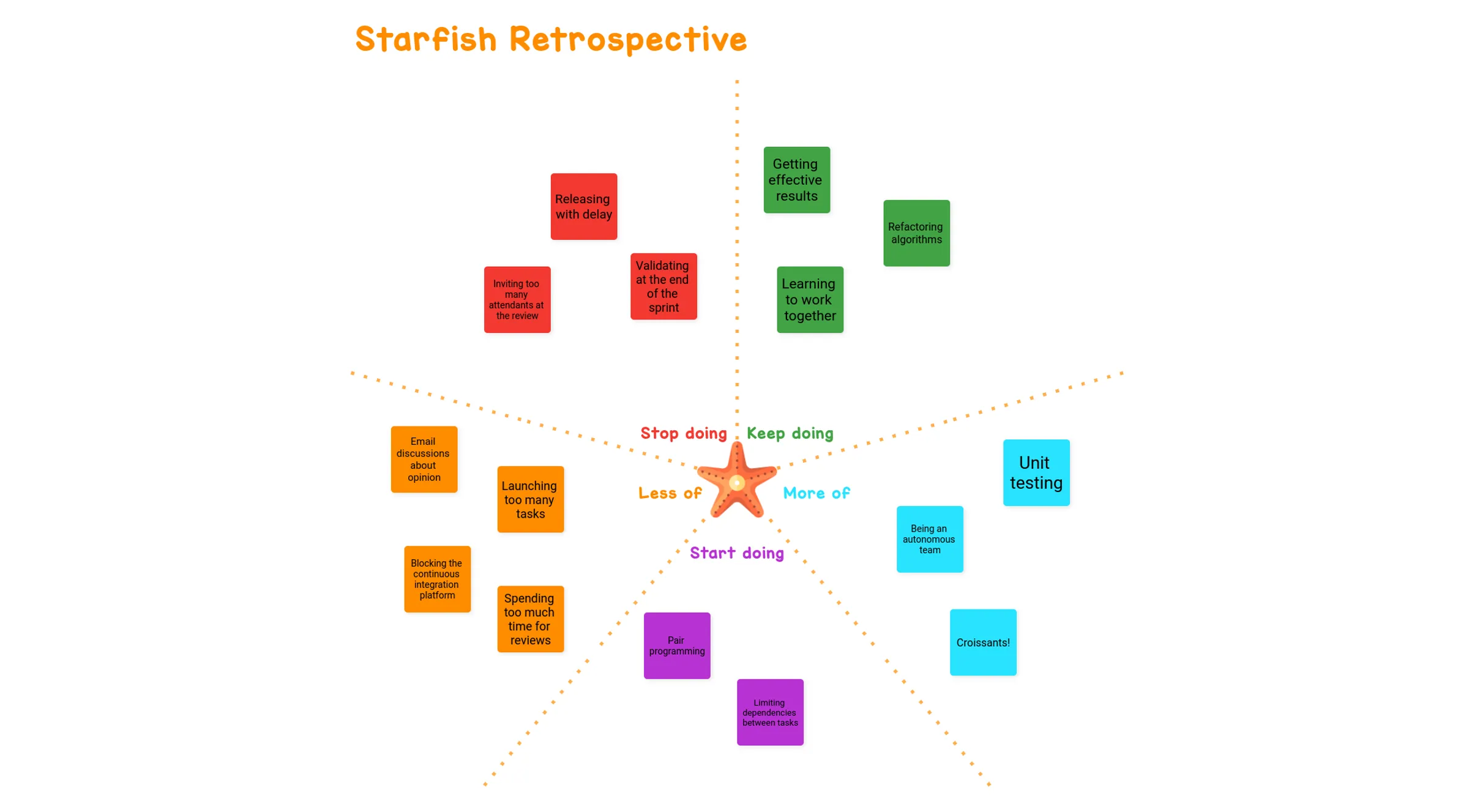Starfish Retrospective

What is the Starfish Retrospective?
The Starfish Retrospective is an Agile project management exercise that forces Scrum teams to take a step back and question the relative effectiveness of the processes and practices being put into place for getting a project off the ground. It’s a classic retrospective format your team will enjoy!
This retrospective is called a “Starfish” because it asks teams to organize their insights and feedback across five key categories (aka, the five arms of a starfish):
- Keep Doing: What are we currently doing that adds a tremendous amount of value to the team?
- More of: What are we currently doing that could add more value if we doubled down on it?
- Start Doing: What should we start doing (or start testing) to help the team work better?
- Less of: What are we currently doing that isn’t driving enough value for the team?
- Stop Doing: What are we currently doing that adds no value to the team whatsoever?
How to run a Starfish Retrospective
The Starfish Retrospective generally takes place in 4 steps:
-
Step 1: Individual reflection
As a facilitator, you should give participants around five to ten minutes to jot down ideas on sticky notes for each of the five categories above. Each sticky note should represent only one idea.
Be sure to use “polling booth mode” to ensure team members don’t inadvertently influence each other with the ideas they choose to submit for consideration. As a best practice, be sure to assign each category a different sticky note color to keep things organized visually.
-
Step 2: Commenting and reorganizing ideas
Once the time cap has been reached, the facilitator reads aloud the participants’ sticky notes placed on the (physical or virtual) board. If something isn’t clear on one of the sticky notes, the participant who submitted it can add a bit of clarification. Additionally, this is the point when other participants can ask questions and discuss the ideas shared in more detail.
-
Step 3: Proposal of areas for improvement
Following the discussion in Step 2, the facilitator gives participants another five to ten minutes to hone in on ideas for improvement and write them down on sticky notes. Once all ideas have been submitted, the facilitator should take a moment to group together similar ideas before sharing them with the team and then putting them up for a vote.
-
Step 4: Selection of areas for improvement
Finally, the facilitator gives each participant an opportunity to vote for the three areas of improvement to be implemented during the next sprint. The three sticky notes with the most votes will be deemed the “winners” of this exercise and put into action immediately.
Tips and advice from an Agile Coach
Naya Luceau, an Agile Coach and Scrum Master, has hosted many Starfish Retrospectives. To make this a collaborative experience for the entire team, she recommends the following:
- When presenting the workshop format to participants, be sure to add a few sticky notes to provide the team with an example of the array of ideas that can be put into each of the five categories. This can include:
- Continue Doing: “Personal Development/Smiling More”
- More of: “Remote Working/Design Workshops”
- Start Doing: “Prioritizing Tasks/Saying “I need help”
- Less of: “Product Bugs/Useless Meetings”
- Stop Doing: “Not Testing/Being Late to Meetings”
- If participants ask why the team takes just as much time to discuss “what’s working” as opposed to staying squarely focused on the areas of improvement, be sure to remind them that this retrospective—like everything in Agile—is part of a continuous improvement process. In other words, it’s important to not only identify what could be done better, based on learnings, but also to celebrate what drives a team’s success.
Suggested resources for learning more about the Starfish Retrospective
- Patrick Kua’s article that introduces this retrospective workshop: The Retrospective Starfish